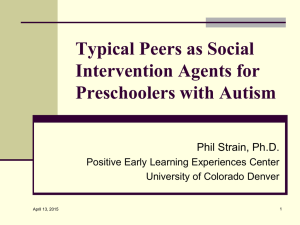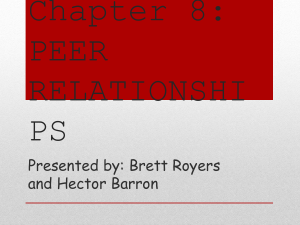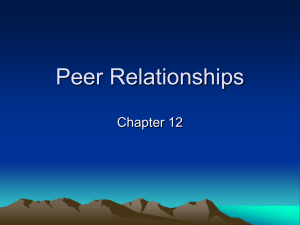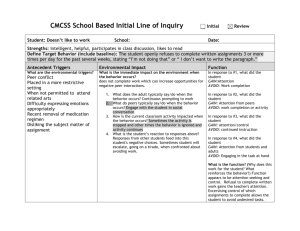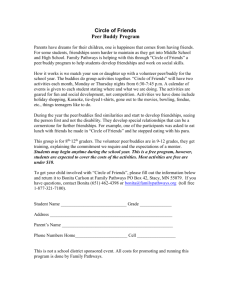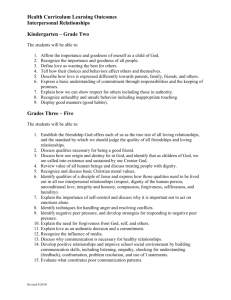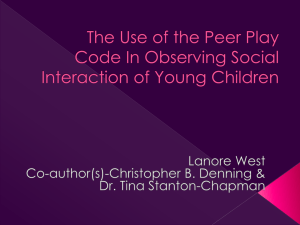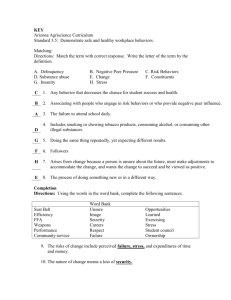Building Healthy Relationships
advertisement
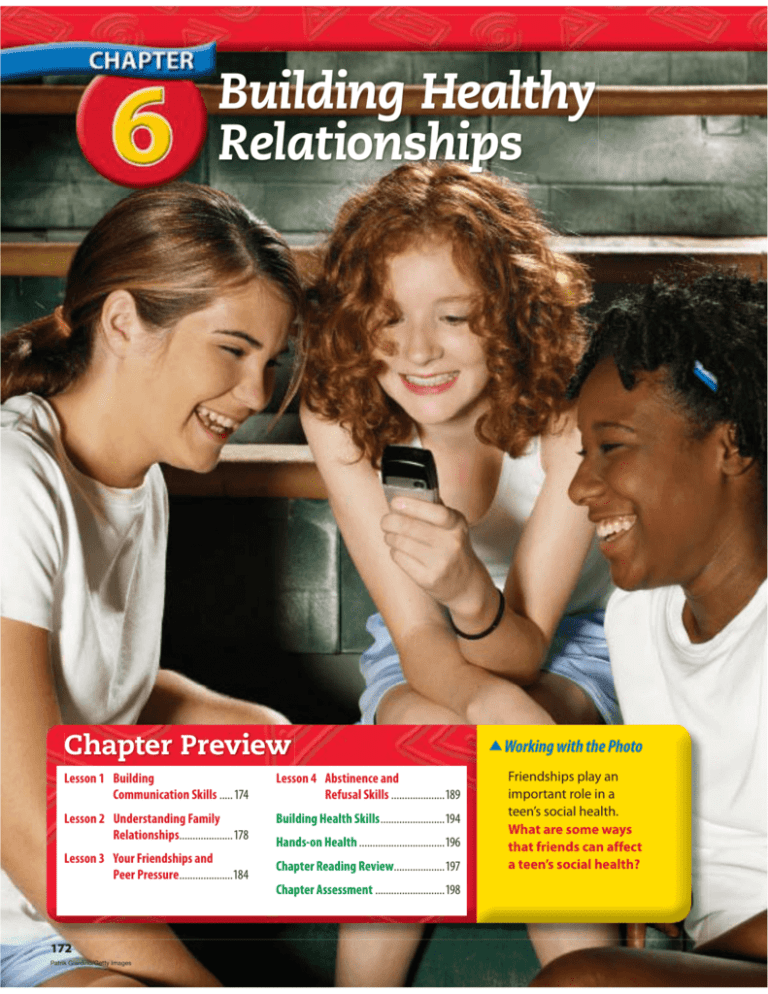
Building Healthy Relationships Chapter Preview Lesson 1 Building Communication Skills .....174 Lesson 4 Abstinence and Refusal Skills ....................189 Lesson 2 Understanding Family Relationships....................178 Building Health Skills ........................194 Lesson 3 Your Friendships and Peer Pressure ....................184 Hands-on Health ................................196 Chapter Reading Review...................197 Chapter Assessment ..........................198 172 Patrik Giardino/Getty Images Working with the Photo Friendships play an important role in a teen’s social health. What are some ways that friends can affect a teen’s social health? Start-Up Activities Do you know how to handle peer pressure? Answer the Health eSpotlight question below and then watch the online video. Keep a record of your answer. Healthy Peer Relationships Learning how to recognize peer pressure will help you develop healthy peer relationships. If a friend encouraged you to do something you knew was wrong, how would you respond? Go to glencoe.com and watch the health video for Chapter 6. Then complete the activity provided with the online video. Make this Foldable® to help you organize what you learn about verbal and nonverbal communication in Lesson 1. Begin with a plain sheet of 8½” × 11” paper. 1 Fold the sheet of paper in half along the long axis. 3 Unfold and cut the top layer along both fold lines. This makes three tabs. 2 Turn the paper, and fold it into thirds. 4 Draw two overlapping ovals and label as shown. A More Perfect Union Communication Verbal Nonverbal Write down the definitions and examples of verbal and nonverbal communication under the appropriate tab. Under the middle tab, describe how both types of communication help to share feelings, thoughts, and information. Visit glencoe.com and complete the Health Inventory for Chapter 6. 173 Lesson 1 Building Communication Skills Building Vocabulary Focusing on the Main Ideas As you read this lesson, write each new term and its definition in your notebook. ■ ■ ■ ■ ■ In this lesson, you will be able to ■ communication (p. 174) verbal communication (p. 175) nonverbal communication (p. 175) body language (p. 175) tact (p. 176) ■ ■ ■ define communication. recognize different ways of communicating. list ways of speaking clearly and listening carefully. demonstrate communication skills. Reading Strategy Predicting Look at the main headings, figures, and captions before reading this lesson. Write a sentence or two to predict the kinds of information you might learn. Use the Foldable® on p. 173 as you read this lesson. Think of a time when a friend didn’t understand what you were trying to say. Write two or three sentences that describe the situation. What Is Communication? Jenna just talked to Paul on the phone about a report for health class. Paul gave her some tips on finding the information she needed for her part of the report. Jenna and Paul communicated. Communication is the exchange of information through the use of words or actions. Every communication needs three parts. The first is the sender. The second is the receiver. The third is the message. Communication depends on all three parts. The message must go from the sender to the receiver. The sender must make the message clear. The receiver must pay attention or the receiver might misunderstand. Then communication breaks down. Every communication requires a sender, a receiver, and a message. What might prevent a message from getting through to a receiver? 174 Richard Anderson When you express yourself clearly and understand other people, you can communicate effectively. Healthy relationships have a lot to do with how you communicate. The better you communicate, the stronger your relationships are likely to be. Good communication skills can help you succeed in all parts of your life. Let’s look at the two types of communication: verbal and nonverbal. List What are the three parts of any communication? Verbal Communication Jenna and Paul used words to talk about their report. Their report will use words to express their ideas. These are examples of verbal communication. Verbal communication is expressing feelings, thoughts, or experiences with words, either by speaking or writing. This is the kind of communication people use most. Verbal communication lets you read a book, a magazine, an Internet site, or a street sign. It lets you keep in touch with people by phone, in person, and by writing letters and e-mail. It also lets you enjoy television, radio, and films. Nonverbal Communication You can send a clear message even when you don’t say anything at all. When you smile, wave, or high-five a teammate after winning a relay race, you’re using nonverbal communication. Nonverbal communication is getting messages across without using words. It uses body language—postures, gestures, and facial expressions— to send messages. Body language is a powerful tool for nonverbal communication. It can give your words extra meaning. It can also send messages you’re not aware of. If you feel calm and sure of yourself when speaking to a group, your body language will show it. For example, someone who feels disapproval might cross his or her arms or frown. Communication Across Cultures Each culture has its own ways to communicate nonverbally. People of some cultures bow to show respect. People of other cultures feel that making direct eye contact during conversation is disrespectful. In the United States, people usually shake hands when they meet for the first time. Research how nonverbal communication varies across cultures. Record your information in a chart. In your chart, include a description of each example and what it communicates. Name Give two examples of nonverbal communication. Body language is important in nonverbal communication. What does the body language of these teens tell you? Lesson 1: Building Communication Skills 175 Royalty-free/CORBIS Communicating Effectively Healthy relationships depend on good communication skills. For others to understand your message, it must be clear. Careful listening is also necessary for effective communication. It shows people that you are interested in what they wish to share. Speaking Skills When you express yourself clearly in words, people understand what you mean. Here are some tips for speaking effectively. Being a good listener is part of communicating effectively. How can you tell that one of these teens is demonstrating good listening skills? • Think about what you want to say. • Use “I” messages to express your thoughts, feelings, needs, and expectations. For example, you might say, “The way I feel about writing the lab report is. . .” This keeps the focus on the message you are trying to get across. • Use tact, the sense of what to do or say to avoid offending others. Avoid being rude or insulting. • Make clear, simple statements. Be specific. Use examples when you express ideas or give suggestions. Listening Skills Effective communication also involves listening carefully. Here are some ways to be a good listener: Visit glencoe.com and complete the Interactive Study Guide for Lesson 1. 176 Chapter 6: Building Healthy Relationships Richard Anderson • Use body language to show you are listening carefully. Lean a bit toward the speaker. Look him or her directly in the eye. From time to time, nod and respond with facial expressions and other body movements. • Take advantage of pauses in the conversation to offer encouragement. Use phrases such as “Really?” or “Tell me more about that.” This shows that you are paying attention. It will also help the speaker feel comfortable about continuing to share. • Do not interrupt. There may be times when you want the speaker to clarify a statement. Politely ask questions until you are sure you understand its meaning. • When possible, mirror what you hear. Repeat or rephrase the speaker’s thoughts and feelings as you understand them. Be sympathetic to show you understand how the speaker feels. Writing Skills You probably communicate in writing every day. You might write e-mails, text messages, or notes. Writing out your thoughts can have advantages. For example, you can make changes before you send your message. However, there are also challenges. If a written message isn’t clear, the receiver can’t always ask you what you meant. The person can’t hear your tone of voice. He or she can’t see your face or your body language. This can cause misunderstandings. You can limit misunderstandings by working on your written communication skills. For starters, think about keeping a journal. You’ll create a record of your experiences while you practice writing. Are there people you usually keep in touch with by phone? These might be family members or out-of-town friends. Why not send a letter or an extended e-mail message next time? E-mail and instant messaging are popular forms of communication. How might electronic communication lead to confusion or misunderstandings? Explain Why is it a good idea to use tact when speaking to others? Lesson 1 Review Review this lesson for new terms, major headings, and Reading Checks. What I Learned 1. Vocabulary Define communication. and other similar phrases. How would you react to hearing them? 2. Identify What are the two types of communication? 6. Synthesize What are some nonverbal ways to show consideration for others? 3. Give Examples List two ways to show that you are listening carefully. Applying Health Skills 4. Explain Explain how body language plays a part in communication. Thinking Critically 5. Apply Imagine you are having an emotional discussion with a friend. Each of your friend’s comments begins with “You always. . .” or “You make me feel. . .” 7. Communication Skills Using tact is an important skill. Imagine that a friend asked for your opinion about a jacket he or she was thinking of buying. You don’t think the jacket looks good. How might you give your opinion honestly but tactfully? For more Lesson Review Activities, go to glencoe.com. Lesson 1: Building Communication Skills 177 Randy Faris/CORBIS Lesson 2 Understanding Family Relationships Building Vocabulary Focusing on the Main Ideas Write a definition for each term below. As you read this lesson, make changes to the definitions as needed. ■ ■ In this lesson, you will be able to ■ ■ ■ ■ family (p. 178) nurture (p. 179) describe the family as the basic unit of society. recognize the functions of the family. list ways to improve family relationships. identify ways to cope with changes in the family. Reading Strategy Skimming Look over the major and minor headings in this lesson. Skimming the lesson will give you an idea of what it is about. Write two or three sentences that describe how family members might help each other when they face the challenge of moving. Everyone Is Part of a Family The family is the basic unit of society and includes two or more people joined by blood, marriage, adoption, or a desire to support one another. Families give people a place to belong. Your family is part of a community, a state, and a country. Your family teaches you values, beliefs, and expectations. Families can be large or small. People within them may have a number of different relationships. Some different types of families are listed below. • A couple consists of two adults living together. • A nuclear family consists of a husband and wife and their child or children. • A blended family consists of one stepparent, one parent, and one or more children. • A single-parent family consists of one parent and one or more children. • An extended family consists of parents, children, and other family members (such as grandparents) living together. Identify Name two types of families. 178 Chapter 6: Building Healthy Relationships How Families Help Their Members A family takes care of physical needs, providing food, water, and shelter for its members. A family also takes care of mental needs. It teaches its members life skills, answers questions, and helps expand knowledge. A family takes care of emotional needs, including love, trust, and security. Most of all, a family nurtures. To nurture means to fulfill physical, mental/emotional, and social needs. Figure 6.1 shows examples of the ways a family nurtures its members. As you grow up, your family helps you develop values and beliefs. These come from your family’s way of life, traditions, culture, and religious beliefs. Your values and beliefs influence the decisions you make, even as an adult. They can influence the type of activities you participate in, the foods you eat, and the type of health care you choose. Your values and beliefs can even help you choose not to participate in risky behaviors, such as using tobacco, alcohol, or drugs. Name What are the three kinds of needs that families meet? FIGURE 6.1 HOW FAMILY MEMBERS CARE FOR EACH O THER Family members meet each other’s needs. What mental needs do families meet? Physical Needs Family members take care of each other with food, clothing, and shelter. Mental Needs In a family, adults and children share knowledge, skills, and experience. Emotional Needs Family members give each other love, acceptance, and support. Social Needs Families teach their members how to get along with each other and with people outside the family. Lesson 2: Understanding Family Relationships 179 Lars Klove Photo Service/Getty Images Roles and Responsibilities Family members have different roles and responsibilities. Can you name some of the roles these family members might have? Every family member has one or more roles, such as parent, child, or sibling. There are responsibilities that come with each role. For example, parents are responsible for providing a place to live, food, and other basic needs for their children. Parents are also expected to teach their children and provide love and emotional support. Children have responsibilities, too. They are expected to cooperate and respect their parents. They may be expected to help with chores around the house. As a teen, your role may include helping younger siblings or grandparents. As you get older, your roles and responsibilities will change as your family’s needs change. You may take on new roles as an adult, such as spouse or parent. A person’s role is always growing or changing depending on his or her age or stage of life. Roles are very important to family life. They help families deal with the challenges of daily life. Sharing roles and responsibilities can help build strong family relationships. Building Family Relationships People in strong families feel connected. They enjoy spending time together. Below are some ways that families can strengthen their relationships. Academic Vocabulary appreciate (uh PREE shee ayt) (verb) to be thankful for, to understand, to increase in value. I appreciate your help with the science fair. 180 Chapter 6: Building Healthy Relationships Rob Lewine/CORBIS • Show appreciation for each other. Families grow stronger when they show that they feel thankful for each other. A simple “Thank you” can show others you notice their efforts. You can also help them when they need it. • Support other family members. Knowing that your family believes in you adds meaning to your successes. It also makes failure easier to handle. Show support for people in your family. Take part in events that are important to them. Help them when they need it. • Spend quality time together. Set aside time for activities everyone enjoys. Spending mealtimes together can help families stay connected. • Communicate effectively. Talking openly helps everyone resolve disagreements. It also helps develop trust and respect. Your discussions should not focus only on problems but on all topics important to people in your family. Communication Skills Communicating with Parents or Guardians Tyler has been dreaming of playing football for a while now. Tryouts for the local team are in two weeks. Tyler needs to talk to his parents first, but he is worried they will not understand how he feels about playing the sport. They want him to have enough time to do homework and study, and practices will take up a lot of time. Tyler is unsure about how to talk to his parents about playing football. With a Group Write a script showing how Tyler talks to his parents about playing football. Use the techniques below to effectively communicate ideas, thoughts, needs, and feelings. Role-play your conversation for the class. • State clear reasons for your request. • Use “I” messages. • Use a respectful tone and stay calm. • Use appropriate listening skills. • Be willing to compromise. • Show responsibility. Some families have charts showing who does certain household tasks each week. When it’s your turn, do your job without being asked. When you share work equally in your family, you appreciate each other’s efforts. • Show respect. Speak to family members in a respectful tone of voice. Show respect for one another’s differences. Don’t tease or make fun of your siblings or other relatives. Respect each other’s privacy and personal belongings, too. Don’t borrow items without permission. • Follow family rules. In your family, you may have rules for when to be home or when you need permission to do an activity. Many families also have rules about telephone, television, or computer use. Following the rules set by your parents or guardians helps build trust within your family. List Give three examples of ways to keep family relationships strong. Responsibility Think of how you fit into your family. Are you a brother, a sister, a son, a daughter, a grandchild, a niece, or a nephew? What are your responsibilities to your family? How do you help others? Make a list of words that you feel describe your family role and responsibilities. Survey family members. Ask them to choose words that describe you. How do the two lists compare? Lesson 2: Understanding Family Relationships 181 FIGURE 6.2 POSITIVE WAYS TO COPE WITH CHANGE IN THE FAMILY Changes that happen in a family affect all family members. What are some serious changes that can affect families? CHANGE POSITIVE WAYS TO COPE Moving to a new home Before the move, look at a map of your new neighborhood. Find your new house, your school, and nearby parks. When in a new neighborhood, try to meet other teens. Separation, divorce, or remarriage of parents Tell both parents you love them. Talk to them or to another trusted adult about how you feel. A separation or divorce is not your fault. Job change or job loss If the family needs to limit spending for a while, ask how you can help. Birth or adoption of a new sibling Spend time with your new sibling. Ask your parents how you can help. Imagine what your relationship might be like in the future. Illness or injury Show that you care about a sick or injured family member by spending time with him or her and asking how you can help. Death, loss, and grief Accept the ways family members express grief. Don’t expect their ways of coping to be the same as yours. Pay extra attention to younger members of the family. Coping with Change Visit glencoe.com and complete the Interactive Study Guide for Lesson 2. 182 Chapter 6: Building Healthy Relationships Alan Powdrill/Getty Images Changes and challenges are a normal part of family life. During difficult changes, keeping up normal routines can help younger family members feel secure. Talking openly can help families decide how to best handle changes. Sometimes outside help is needed to deal with serious changes. Family members can go to counselors, health care workers, religious leaders, or people from law enforcement to get help. They may see legal advisors. Figure 6.2 above lists some changes that can affect families. It also describes some positive strategies for coping with these changes. Families Work Together For most people, the family stands at the center of their lives. Children turn to family for learning, love, and security. They learn how to build relationships and stand on their own. As adults, people usually feel that building families is very important. People who enjoy healthy family relationships are more likely to enjoy healthy relationships with others. Identify Name two ways families work together. Appreciating each other goes a long way toward building and maintaining good family relationships. How can you show respect for members of your family? Lesson 2 Review Review this lesson for new terms, major headings, and Reading Checks. What I Learned 1. Vocabulary Define nurture. 2. Explain What is the connection between family nurturing and the well-being of society? 3. Give Examples What are two ways to strengthen family relationships? 4. Identify Name two changes that a family might face. 6. Infer How might spending time with extended family members strengthen a teen’s mental/emotional health? Applying Health Skills 7. Analyzing Influences Think of a television show about a family. What kinds of relationships do the actors play out? Write a few sentences to describe this family. Do you think this TV family is realistic and healthy? Why or why not? Thinking Critically 5. Apply Describe three ways that a teen can support a family member in need. For more Lesson Review Activities, go to glencoe.com. Lesson 2: Understanding Family Relationships 183 Ken Karp Lesson 3 Your Friendships and Peer Pressure Building Vocabulary Focusing on the Main Ideas As you read this lesson, write each new term and its definition in your notebook. ■ ■ ■ ■ ■ ■ In this lesson, you will be able to ■ friendship (p. 184) acquaintance (p. 184) compromise (p. 186) peers (p. 187) peer pressure (p. 187) assertive response (p. 187) Write a brief paragraph describing someone you know who is a good friend to others. ■ ■ ■ explain why friends are important. identify the characteristics of a good friendship. recognize ways of keeping friendships strong. describe ways to resist negative peer pressure. Reading Strategy Identifying Cause and Effect After reading this lesson, write a list of ways to build strong friendships. Friends Are Important The family is one source from which children learn social skills. Friendships are another. A friendship is a relationship with someone you know, trust, and regard with affection. Your friends usually are people who live near you or who like the same things you do. Friends also have similar values. Strong friendships are a building block for social health. Strong friendships take time to develop. Some people have only one close friend, while others have several. Some people have many acquaintances. An acquaintance is someone you see occasionally or know casually. In time, some of your acquaintances may become your close friends. Having friends teaches you to communicate, work out problems, and compromise. You learn to give others support and to consider their feelings. Friendships also let you share your life, the good and the bad, with people who know you well. Having someone with you to share good times is one of the benefits of friendship. What are some other benefits of friendship? 184 Michael Keller/CORBIS Traits of a Good Friend Some people confuse the terms friend and acquaintance. A friend is much more than an acquaintance. Friends are people you spend lots of time with and know very well. You value your friendships. In fact, they may be some of your most important relationships. Good friendships make you and your life better. People form friendships for many reasons. They may have common interests. They may live in the same neighborhood. Most friendships have the following qualities. What makes a good friend? A good friend is someone who listens and is always there when you need to talk. She or he also has to have the same interests. This is what I think makes a good friend. • Trust. Good friendships are based on honesty. Friends share their thoughts openly. You can also trust good friends to support you in tough times. • Caring. True friends care about each other’s well-being. A good friend will listen and try to understand how you feel. True friends recognize your strengths and help you build on them. They accept you as you are. • Respect. Friends may not all share the same beliefs, but that’s okay. Good friends respect each other’s differences and treat each other as equals. They won’t ask you to do anything that could hurt you or put you in danger. They won’t expect you to act against your values. • Loyalty. True friends stay together in good times and bad. They support each other and forgive mistakes. A loyal friend will not let others say untrue or mean things about you. Emily P. Tucson, AZ Identify What are two traits of good friendship? Building Friendships Some people make friends easily, while others find it more difficult. Making new friends can be easier when you join groups who have interests similar to yours. Check out a sports team or a club. You are more likely to meet people who share your interests when you spend time doing activities that you like. Figure 6.3 on the next page shows some ways to build friendships. Lesson 3: Your Friendships and Peer Pressure 185 FIGURE 6.3 3PENDMORETIME WITHYOURFRIENDS BUILDING STRONG FRIENDSHIPS )DENTIFYPROBLEMSAND TRYTORESOLVETHEM One way to build strong friendships is to help friends when they need it. Name two other ways to build strong friendships. #OMMUNICATEOPENLY ANDHONESTLY "ETHEREWHENYOUR FRIENDSNEEDHELP %NCOURAGEYOURFRIENDS TOGOFORTHEIRGOALS Building and maintaining positive friendships is important. You can build stronger friendships through tolerance. Tolerance is the ability to accept other people as they are. This means that you are respectful of a person’s individual differences, race, or culture. Tolerance will help you get along better with your friends and acquaintances. Knowing When to Compromise Social Worker Social workers help people deal with a wide range of problems, including family relationships, unemployment, and serious illness. As the population of the U.S. gets older, more social workers who specialize in helping older people will be needed. You can prepare for a career in social work by taking sociology, family & consumer science, and pschology courses. What skills does a social worker need? Go to Career Corner at glencoe.com to find out. 186 Chapter 6: Building Healthy Relationships LWA-Dann Tardif/CORBIS Being friends with someone does not guarantee that you will never have disagreements. You might even argue. Sometimes it is hard to find a solution. What do you do when this happens? In most cases, you can choose to protect your friendship by working out your differences. When disagreements happen, friends are willing to compromise. Compromise is when both sides in a conflict agree to give up something in order to reach a solution that satisfies everyone. Friends may need to compromise on what to do when they are together or when they want others to join their social circle. They may need to find a way to meet in the middle when they disagree. Compromise is the answer for many disagreements, but sometimes it is not the best choice. For example, you should never compromise when you would have to act against your values. You should not compromise when you might end up harming yourself or others. If a friend asks you to do something you know is unlawful or wrong, you should always be firm and say no. Define What is compromise? Peer Pressure Most of your friends are probably your peers, people close to you in age who are a lot like you. Sometimes teens worry about what their friends think about them. Your friends’ opinions can affect how you act. This is called peer pressure, the influence that your peer group has on you. Peer pressure can be negative or positive. Visit glencoe.com and complete the Interactive Study Guide for Lesson 3. Negative Peer Pressure Friends should not pressure you to do something that is unhealthy or unsafe, or that goes against your family’s values. For example, friends should not pressure you to use tobacco, alcohol or other drugs. They should not ask to copy your homework or ask you to break the rules of your school or community. True friends will respect your choices. Negative peer pressure can take many forms. Encouraging a person to act in a way that is harmful or illegal is one form of negative pressure. Other forms include bribes, dares, or threats. Negative peer pressure can also come in the form of teasing or name-calling. You can learn to recognize negative peer pressure by using the H.E.L.P. criteria. H.E.L.P. stands for Healthful, Ethical, Legal, and Parent approved. If what your friends are asking you to do doesn’t fit the criteria, don’t go along. Figure 6.4 shows you some effective ways to resist negative peer pressure. FIGURE 6.4 RESISTING NEGATIVE PEER PRESSURE Resisting peer pressure is a skill you can learn. How can you handle negative peer pressure in your life? Avoid the Situation. If you can tell that a situation might be unsafe or harmful, don’t participate. Use assertive responses. If your friends want to involve you in a dangerous situation, say no. Use an assertive response. This is a response that declares your position strongly and confidently. Focus on the issue. If your friends make fun of you. Don’t defend yourself or trade insults. Walk away. It’s best to talk things out with friends who try to pressure you. If someone becomes angry, walk away. Lesson 3: Your Friendships and Peer Pressure 187 Richard Anderson Positive Peer Pressure Your friends give positive peer pressure when they suggest you do the right thing. They may encourage you to study more. They may advise you to work on a group project or become a volunteer. They may suggest you join the science club at school or ask you to welcome new people into the group. Friends can help you say no to risk behaviors, such as using tobacco. Positive peer pressure can be good for you. It can improve your health and safety and help you feel better about yourself. Explain What is an assertive response? Your peers can have a positive influence on your health. Give an example of positive peer pressure. Lesson 3 Review Review this lesson for new terms, major headings, and Reading Checks. What I Learned Thinking Critically 1. Vocabulary Define friendship. 6. Analyze Why is tolerance important to a healthy society? 2. Identify What are three qualities of a good friend? 3. List Name three ways to build strong friendships. 4. Distinguish What is the difference between negative and positive peer pressure? 5. Explain When is it important to walk away from a situation in which you face negative peer pressure? 188 Chapter 6: Building Healthy Relationships David Young-Wolff/PhotoEdit 7. Comparing and Contrasting Explain the consequences that both positive and negative influences from a peer can have on a teen’s life. Applying Health Skills 8. Analyzing Influences Do you think adults experience as much pressure from their peers as teens do? Write a brief paragraph explaining why or why not. For more Lesson Review Activities, go to glencoe.com. Lesson 4 Abstinence and Refusal Skills Building Vocabulary As you read this lesson, write each new highlighted term, its definition, and an example. ■ ■ ■ risk behaviors (p. 190) abstinence (p. 190) refusal skills (p. 192) Focusing on the Main Ideas In this lesson, you will be able to ■ ■ ■ ■ identify risk behaviors. recognize the benefits of abstaining from the use of tobacco, alcohol, and other drugs. recognize the benefits of practicing abstinence from sexual activity. apply refusal skills by using the S.T.O.P. formula. Reading Strategy Finding the Main Idea Review all the headings in this lesson. For each main heading, write one sentence that states what you think the main idea of the section will be. Acting Responsibly Growing up means taking on more responsibility in all areas of life. Your parents recognize that you can make decisions for yourself and choose right from wrong. This additional responsibility also leads to more freedom. You might be allowed to go more places by yourself or with your friends. Your responsibilities include taking care of your body and mind. How can you show responsibility for yourself? Some ways are simple, such as choosing healthy foods. Some are more challenging, such as staying away from risk behaviors. Write a brief paragraph explaining why teens should avoid risk behaviors. As you grow up, adults trust you with more responsibilities. What kinds of responsibilities are associated with being a teen? Lesson 4: Abstinence and Refusal Skills 189 Lars Klove Photo Service/Getty Images Abstinence from Risk Behaviors Topic: Setting Healthy Limits Visit glencoe.com for Student Web Activities where you can learn about the challenges teens may have setting healthy limits and how to address these challenges. Activity: Using the information provided at the link above, list 10 things that teens should know and do to set healthy limits in relationships. Teens can let others know they don’t approve of risk behaviors in a variety of ways. What might these teens hope to achieve through this event? 190 Richard Anderson Risk is a part of life. You take a risk when you make a new friend or when you compete in a sporting event. Risks can be scary at times, but they are often worthwhile. As you get older, you will take risks when you choose a career, a place to live, and make other life decisions. These are positive risks that will help you grow. Not all risks are worth taking, however. It just doesn’t make sense to engage in risk behaviors that could put you or your health in danger. Risk behaviors are actions or choices that may harm you or others. Using tobacco, alcohol, or illegal drugs are risk behaviors. Other risk behaviors include engaging in sexual activity or breaking the law. A teen’s best response to risk behaviors is abstinence, which is the conscious, active choice not to participate in high-risk behaviors. By abstaining from risk behaviors, you can avoid serious negative consequences. For example, when teens abstain from sexual activity, they don’t have to worry about unplanned pregnancy or exposure to sexually transmitted diseases. Avoiding risk behaviors will benefit your physical, mental/ emotional, and social health. Figure 6.5 shows some of the benefits of practicing abstinence. Identify What are some risk behaviors that teens should avoid? Abstinence from Tobacco, Alcohol, and Other Drugs Abstaining from using tobacco, alcohol, and other drugs is the most healthful choice. It protects you from the dangers of using these substances. The dangers include: • Harm to your physical health. Tobacco, alcohol, and other drugs can seriously affect your body and mind. Smoking is linked to heart and lung disease, including cancer. Alcohol and other drugs can harm the liver and nervous system. • Risk of becoming dependent. If you start using tobacco, alcohol, or other drugs, you may not be able to quit without help from a health care professional. FIGURE 6.5 B ENEFITS OF ABSTINENCE FROM R ISK B EHAVIORS Practicing abstinence protects all areas of your health. How does abstinence protect your social health? Risk Behavior Benefits of Practicing Abstinence Tobacco use • • • • Avoid becoming dependent Reduce the risk of lung cancer and other diseases Keep clothes, hair, and breath smelling fresh Protect others from breathing tobacco smoke Alcohol and other drug use • • • • Avoid becoming dependent Protect the heart, liver, and nervous system Stay focused on goals and dreams Avoid legal consequences Sexual activity • • • • Prevent STDs, including HIV/AIDS Avoid unplanned pregnancy Protect self-esteem and earn others’ respect Build better relationships • • Having trouble with the law. Society recognizes that alcohol and tobacco are not appropriate for young people. As a result, it is illegal to use tobacco if you are under 18 and illegal to use alcohol if you are under 21. Using certain drugs, such as marijuana or cocaine, is illegal for everyone. Having or using these illegal substances can lead to serious legal consequences. Not reaching your goals. Using tobacco, alcohol, or other drugs affects every area of your life and can threaten the goals you set for yourself. These risk behaviors can harm your physical health and hurt your performance in school. They can decrease your commitment to abstain from sexual activity. Your relationships can suffer, too. Academic Vocabulary appropriate (uh pro PREE uht) (adj) acceptable, agrees with some custom or rule, suitable for the purpose. Reading or studying quietly is appropriate behavior in the library. You know how harmful these risk behaviors are for your health. The most healthful decision is to avoid them. Abstinence from Sexual Activity The decision to become sexually active requires maturity and responsibility. These character traits are still developing during the teen years. As a result, abstinence from sexual activity until marriage is the best choice for teens. By abstaining from sexual activity, teens can focus on building healthy relationships and fulfilling their dreams and goals. Lesson 4: Abstinence and Refusal Skills 191 Visit glencoe.com and complete the Interactive Study Guide for Lesson 4. There are many healthy ways to show affection and respect. How are these teens showing their affection for each other? Abstinence from sexual activity is the only responsible choice for teens. Why? People who abstain from sexual activity until marriage never have to worry about unplanned pregnancy and the difficult decisions that go with it, such as adoption. They don’t have to worry about sexually transmitted diseases (STDs). Abstinence until marriage is the only method that is completely effective in avoiding STDs and unplanned pregnancy. Abstinence also gives teens freedom to get to know people without the pressure of engaging in sexual activity. They can develop appropriate feelings of love and trust without the emotional worries that come with sexual activity. Practicing abstinence reflects respect for yourself and for others. If you want to show others you care for them, you can do so in healthful ways that don’t involve sexual activity. You can offer support to others by talking to them, by listening to their opinions, or by hugging or holding hands to show affection. Describe Name two positive consequences of abstaining from sexual activity. Developing Effective Refusal Skills To avoid engaging in risk behaviors, you need to know and practice refusal skills, or strategies that help you say no effectively. Refusal skills are useful whenever you feel pressure to do something you do not want to do. The S.T.O.P. formula can help you remember four effective refusal skills. • Say no in a firm voice. • Tell why not. • Offer another idea. • Promptly leave. When you say no, make sure your body language matches what you are saying. Offer brief but sensible reasons for your choice. Suggest an alternative activity that everyone can enjoy. If you have to, leave the scene. That immediately takes away someone’s power to pressure you into something you do not want to do. Explain What does S.T.O.P. stand for? 192 Chapter 6: Building Healthy Relationships Richard Lord/PhotoEdit Refusal Skills Saying No to Risk Behaviors It’s Saturday night and Zoe is at a party at a friend’s house. At first it, seems like a fun party. However, Zoe soon realizes that her friend’s parents are not home and some of the people who show up are older. She notices a lot of people smoking. She even sees a few bottles of beer around. Zoe decides this party is not for her. She calls her parents to pick her up. While she’s waiting, someone offers her a cigarette. What Would You Do? Using the S.T.O.P. formula, write down what you would say to refuse the cigarette. The formula involves the following steps: • Say no in a firm voice. • Offer another idea. • Tell why not. • Promptly leave. Lesson 4 Review Review this lesson for new terms, major headings, and Reading Checks. What I Learned Thinking Critically 1. Vocabulary What is abstinence? 6. Apply Suppose one of your friends started smoking. What would you tell him in order to help him make a healthy choice? 2. Identify Give two examples of risk behaviors. 3. List What are three benefits of not using alcohol? 4. Describe What are three benefits of abstaining from sexual activity until marriage? 5. Explain What are the four steps of the S.T.O.P. formula? 7. Analyze Think of a risk behavior that could have long-term negative effects for a teen. Analyze what these effects might be. Explain the effects in a short paragraph. Applying Health Skills 8. Decision Making Suppose a friend wants you to take part in a risk behavior. In a brief paragraph, apply the steps of the decision-making process to make a responsible choice in this situation. For more Lesson Review Activities, go to glencoe.com. Lesson 4: Abstinence and Refusal Skills 193 What Are Communication Skills? Communication Skills involve learning how to effectively express yourself and understand others. Speaking Skills Accessing Information Practicing Healthful Behaviors Stress Management ■ ■ ■ Analyzing Influences Communication Skills Refusal Skills ■ Listening Skills Think before you speak. Use “I” messages. Be direct, but avoid being rude or insulting. Make eye contact, and use appropriate body language. ■ ■ ■ ■ Use conversation encouragers. Pay attention. Show empathy. Avoid interrupting, but ask questions where appropriate. Conflict Resolution Decision Making Goal Setting Advocacy Expressing Your Feelings Follow the Model, Practice, and Apply steps to help you master this important health skill. Model Read how Jasmine uses communication skills to work out a conflict with her friend, Holly. Holly was disappointed that her babysitting job was canceled. She was counting on the money she would earn to buy a new CD. When Holly tried to tell Jasmine how disappointed she was, Jasmine just brushed her off. Holly was angry and avoided Jasmine for the rest of the day. The next day, Jasmine used the communication skills she had learned to work things out with Holly. She found Holly and started the conversation with this “I” message. “I feel bad about not paying more attention to your problem. I know you were looking forward to buying that CD. (shows empathy) Did you find out why the babysitting job was canceled?” (ask questions) Jasmine listened while Holly explained and soon the girls were on good terms again. 194 Royalty-free/Getty Images Practice Kayla wants to use communication skills to show support for her brother, Alec. Read the passage and then practice communication skills by answering the questions that follow. Kayla’s younger brother Alec is upset about the low grade he received on his science paper. Kayla knows that Alec didn’t spend much time working on the paper and is about to criticize him for it. Then she stops herself and decides to use better communication skills. 1. What should Kayla say and do in her conversation with Alec? 2. How can Kayla show empathy? 3. In what way is Kayla strengthening the relationships within her family? Apply Apply what you have learned about using good communication skills by completing the activity below. With a small group, brainstorm family situations that require good communication skills. Choose one of the situations and write a script showing behaviors, dialogue, and body language that demonstrate good communication skills. When you’re finished, exchange scripts with another group. Read the group’s script and label the communication skills that are used. Describe how the communication would contribute to the health of the family. Self-Check ■ ■ ■ Did we include evidence of good communication in our script? Did we correctly identify the communication skills used? Did my group describe how the communication would build healthy relationships in the family? Building Health Skills 195 Royalty-free/Jupiterimages One Story, Three Endings Conflicts happen because people have different wants, needs, and opinions. There are at least three ways to handle conflict: denial, confrontation, and problem solving. Denial is when people don’t admit they are angry and don’t talk about their feelings. Confrontation happens when the people are not willing to listen to each other or refuse to compromise. Problem solving occurs when people talk about the problem without insulting or blaming each other. What You Will Need ■ The story: Omar and Lou are playing basketball. Peter comes over and asks if he can play. ■ Ending #1: Omar says, “Sure.” Lou doesn’t like Peter and would rather that he didn’t play. Instead of saying anything, he just shrugs his shoulders and keeps playing, yet he doesn’t try to do well. Peter asks him what’s bothering him. Lou says, “Nothing.” ■ Ending #2: Omar says, “Sure.” Lou claims that Peter always cheats and hogs the ball. Peter replies, “You don’t want me to play because I’m better than you.” Lou throws the basketball down and walks away. ■ Ending #3: Omar says, “Sure.” Lou says no because Peter always hogs the ball. Omar suggests they take turns and trade off after every three shots so no one will have to wait long. They all agree and start to play. 196 Chapter 6: Building Healthy Relationships Michael Newman/PhotoEdit What You Will Do 1 Your teacher will divide the class into groups of three. In your group, read the story using the first ending. Then, answer these questions on a sheet of paper: Does this solution make someone angry? Who? Were the boys listening to each other? Did they understand each other’s feelings? 2 Read the story again using the second ending and answer the same questions. 3 Read the story again using the third ending and answer the questions once more. Wrapping It Up You should be able to recognize the three conflict resolution styles in the three endings of the story. The best ending is when problem solving takes place. Reading Review Foldables® and Other Study Aids Take out the Foldable® that you created for Lesson 1 and any graphic organizers that you created for Lessons 1–4. Find a partner and quiz each other using these study aids. Lesson 1 Building Communication Skills Main Idea Good communication skills involve sending a clear message and listening carefully to messages from others. • The two types of communication are verbal and nonverbal. • To speak effectively you should use “I” messages, use tact, and be specific. • To be a good listener, use body language to show interest, do not interrupt, and mirror what you hear. Lesson 2 Understanding Family Relationships Main Idea Families work together to meet the physical, mental/emotional, and social needs of each member. • The family is the basic unit of society. • Ways to build strong family relationships include showing appreciation, supporting each other, spending time together, communicating effectively, showing responsibility and respect, and following family rules. Visit glencoe.com to download quizzes and eFlashcards for Chapter 6. Lesson 3 Your Friendships and Peer Pressure Main Idea Building strong friendships is important to good social health. • Good friendships have the qualities of trust, caring, respect, and loyalty. • Positive peer pressure can influence you to make healthy choices. Negative peer pressure can influence you to act in a way that may be harmful or illegal. • Resist negative peer pressure by avoiding harmful situations, walking away, or using assertive responses to say no. Lesson 4 Abstinence and Refusal Skills Main Idea Abstaining from risk behaviors, such as tobacco, alcohol, drug use, and sexual activity, is the healthy choice for teens. • Abstaining from tobacco, alcohol, and drug use protects your physical health, protects you from legal consequences, and allows you to focus on your goals. • Abstaining from sexual activity until marriage prevents unplanned pregnancy and STDs, including HIV/AIDS. • Refusal skills, such as the S.T.O.P. strategy, can help you say no to risk behaviors. • Talking openly can help families cope with changes. Chapter 6: Reading Review 197 Assessment Now that you have read the chapter, look back at your answer to the Health eSpotlight question on the chapter opener. Have your ideas changed? What would your answer be now? Reviewing Vocabulary and Main Ideas On a sheet of paper, write the numbers 1–5. After each number, write the term from the list that best completes each statement. On a sheet of paper, write the numbers 6–16. Write True or False for each statement below. If the statement is false, change the underlined word or phrase to make it true. Lesson 3 Friendships and Peer Pressure 6. The influence that people your own age have on you is called nurturing. 7. You can use the H.E.L.P. criteria to resist negative peer pressure. 8. Trust is a trait of good friendships. • • • • tact • nurture family • role body language • compromise verbal communication Lesson 1 Building Communication Skills 9. Friends urging you to come to a party where there might be alcohol is an example of positive peer pressure. 10. An acquaintance is someone you see occasionally or know casually. 11. Tolerance involves accepting others as they are. 1. Expressing your feelings, thoughts, and experiences in words, through speaking or writing, is _________. 2. _________ includes posture, gestures, and facial expressions that send messages. 3. Knowing what is appropriate to say is known as _________. Lesson 2 Understanding Family Relationships 4. The _________ is the basic unit of society and includes two or more people brought together by blood, marriage, adoption, or a desire for mutual support. 5. To _________ is to fulfill physical, Lesson 4 Abstinence and Refusal Skills 12. Teens should practice abstinence when it comes to risk behaviors. 13. Part of developing good refusal skills is learning how to apply the S.T.O.P. formula. 14. Using tobacco is a risk behavior. 15. A teen who practices abstinence from risk behaviors such as sexual activity or using tobacco, alcohol, or other drugs will experience negative legal consequences. 16. Tobacco, alcohol, and other drugs can seriously affect your mind and body. mental/emotional, and social needs. 198 Chapter 6: Building Healthy Relationships Visit glencoe.com and take the Online Quiz for Chapter 6. Thinking Critically Using complete sentences, answer the following questions on a sheet of paper. 17. Analyze How do positive relationships affect your physical and mental/emotional health? 18. Infer What effect does abstaining from Relationships Made Real Use a digital camera to create a PowerPoint® presentation that reflects a clear understanding of good communication skills. Follow the steps below to complete your project. ■ risk behaviors have on your relationships? Write About It 19. Descriptive Writing Design a greeting card for someone who has had a positive influence on your life. Write a message for the inside of the card that includes specific examples of how that person has positively influenced your life. 20. Narrative Writing Write a skit that shows a situation in which a teen uses each step of the S.T.O.P. formula to refuse to participate in a risk behavior. ■ ■ ■ ■ ■ Take 5-7 digital images of students on campus interacting with peers. Import the images into your photo software for later use. Write a script, using a dialogue format, to accompany each photograph taken. Be sure the dialogue uses both verbal and nonverbal communication. Open a new PowerPoint® project with 3-5 slides. Select the slide layout that has both an image and text box, side by side. Import one image onto each slide. Type dialogue text on each slide. Make sure your message is clearly delivered. Save your work. Standardized Test Practice Directions for Writing Writing Write an essay to persuade your principal to organize more after-school activities. Give some examples of activities you think would be worthwhile. Think of some benefits you feel these activities would have, and explain them in your essay. Use a respectful tone, but take a firm position. You know that spending time with your friends builds stronger friendships. Strong friendships and positive peer pressure can add to your school success and your overall good health. You’d like to see your school offer more after-school activities. You think this is a good idea for several reasons: First, these activities would strengthen relationships between students. Second, parents would have a safe place for their children to go after school. Third, teens would have fun and improve their skills. TEST-TAKING TIP Budget your time during an essay test. Read over all the essay questions and give yourself guidelines for how much time to spend answering each one. Chapter 6 Assessment 199
